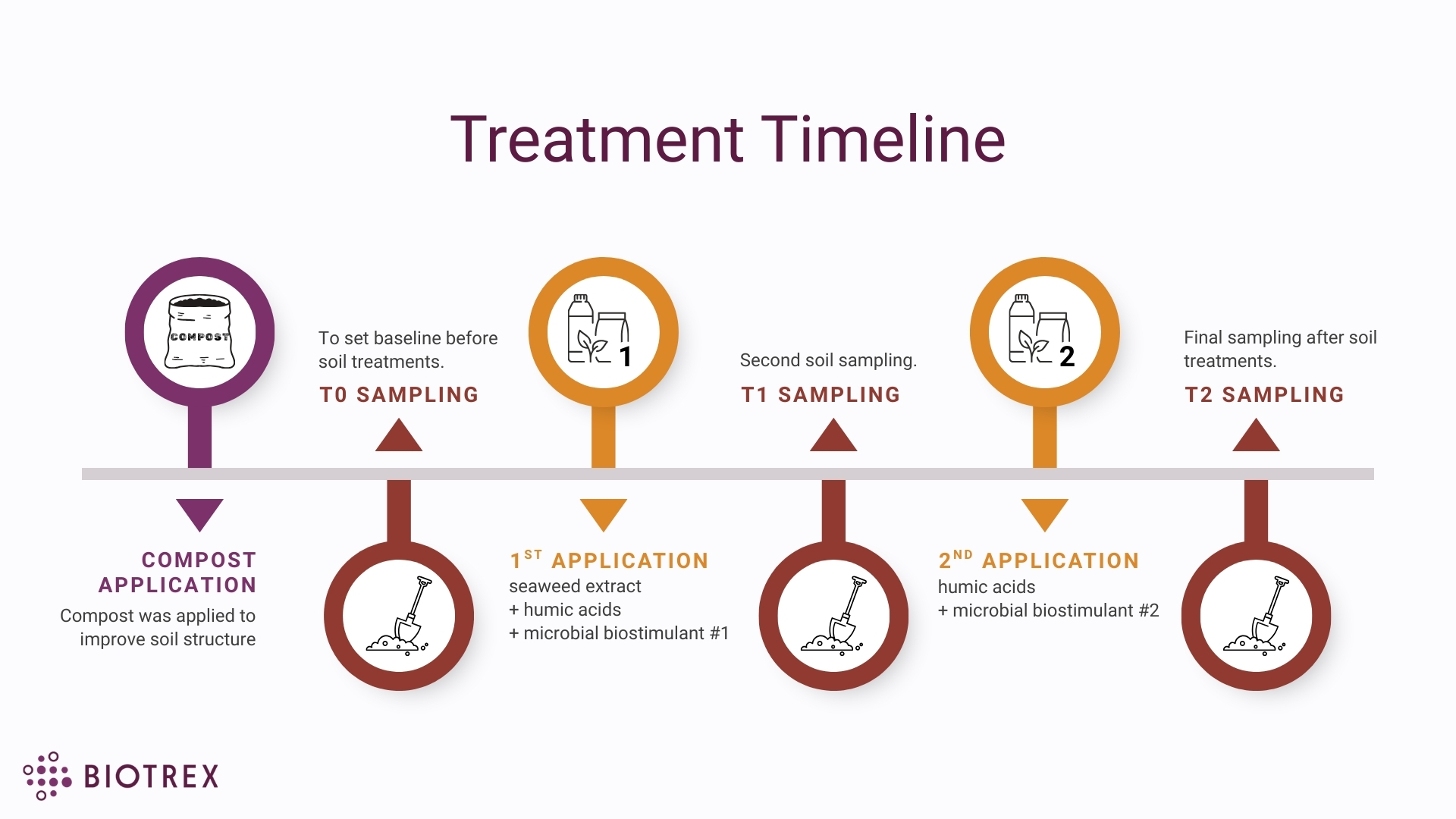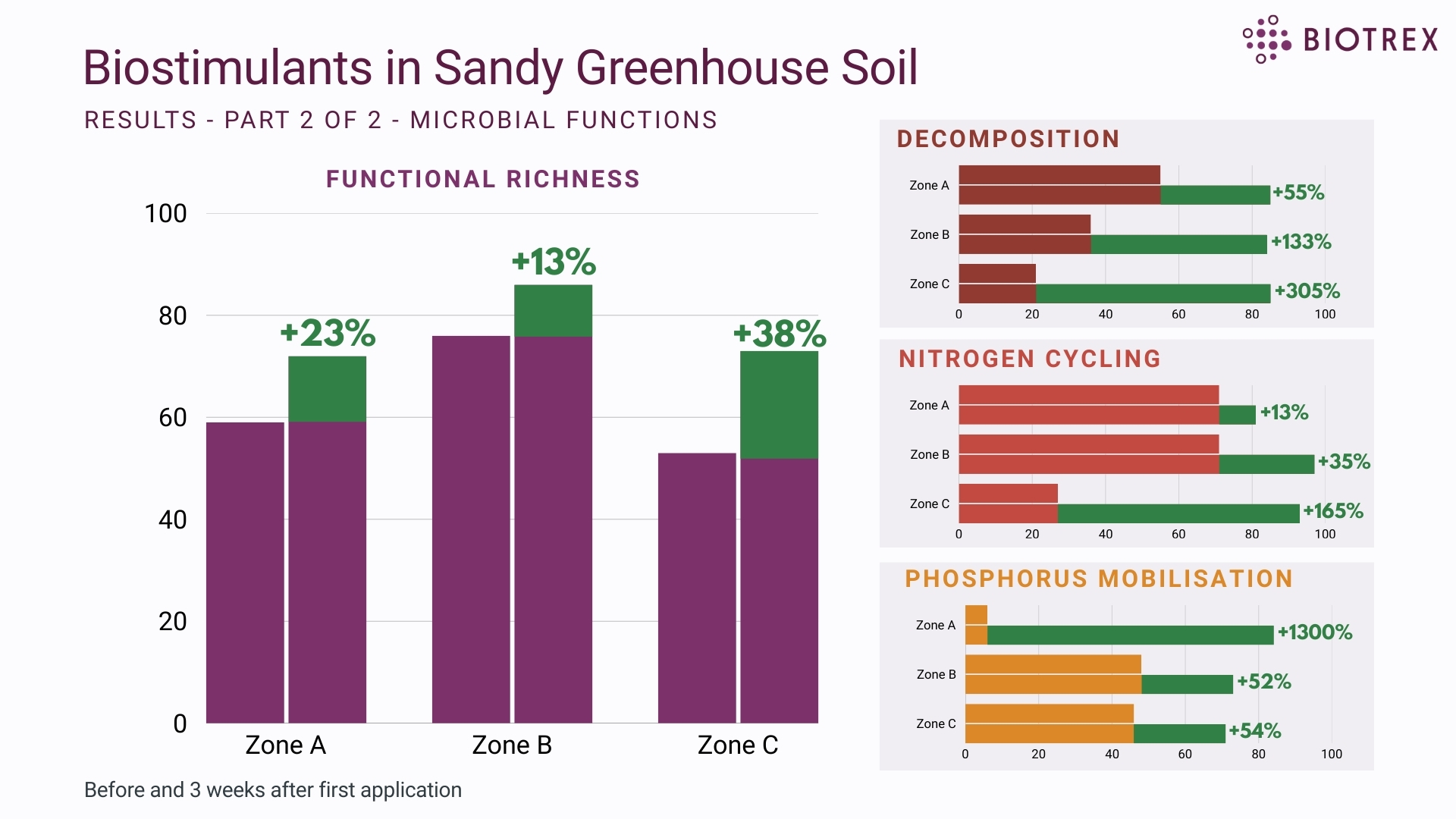Introduction
In Portugal, where summers are hot and dry and the soil is often sandy, our customer — a tomato grower — was faced with a familiar challenge: improving soil fertility within a short window of time. His greenhouse season was about to begin, yet the soil biology was not ready to sustain a demanding crop like tomatoes. With only a few weeks to prepare, he applied a targeted combination of microbial biostimulants, humic acids, and seaweed extracts.
BIOTREX soil microbial analysis was used to quickly assess the effectiveness of these interventions. This provided clear, data-driven insight into how the soil microbial community responded to the treatment – an essential advantage when every week counts before planting. The introduction of our new functional indicators – Decomposition, Nitrogen Cycling, and Phosphorus Mobilisation- allowed us to capture not only overall performance but also specific functional shifts within the microbial community. The results were highly encouraging, revealing a marked improvement in soil function within a remarkably short period.
Sandy Soils: The Challenges for Soil Biology
Soil biology, and particularly the activity of soil microbes, is fundamental to long-term soil fertility. Soil microorganisms deliver essential ecosystem services: decomposing organic matter, cycling nutrients, improving soil structure, enhancing water retention, and helping to suppress plant pathogens.
Sandy soils, however, create a demanding environment for microbial life:
- Low organic matter reduces both microbial diversity and activity. With limited organic inputs, nutrient availability for microbes is restricted
- Poor water-holding capacity creates instability. The coarse texture of sandy soils accelerates drainage and increases vulnerability to drought, leading to fluctuating moisture conditions that stress microbial populations.
- Low nutrient retention constrains microbial metabolism. High porosity and low cation exchange capacity make it difficult for sandy soils to hold onto nutrients, challenging the survival and growth of microbes.
In a greenhouse setting, these challenges can be amplified. High-density planting, rapid crop growth, and intensive nutrient demands place additional pressure on the soil ecosystem. In such conditions, maintaining an active and functionally diverse microbial community is not just beneficial – it is essential for efficient nutrient cycling, disease suppression, and sustained crop productivity.
Time Zero: What Was The Initial Condition of the Greenhouse Soil
Two weeks before the first sampling, the compost was applied with the primary goal of improving soil structure. According to our client, the compost was of relatively poor quality and unlikely to provide significant biological benefits.
The first analysis (T0) was carried out in three greenhouse zones (A, B, and C), each with its own irrigation system. This zoning allowed for a more precise evaluation of spatial variability in soil biology. Overall, the results showed encouraging microbial activity, indicating that microbes were metabolically active despite the challenging sandy texture of the soil. However, the functional indicators provided a more detailed perspective:
- Microbiome Status indicators revealed an active and diverse microbial community overall, with the exception of Zone C, which showed a significantly lower score.
- Functional Richness, an indicator of the variety of functions that the microbial community can perform, suggested that some important microbial functions might be underperforming.
- Decomposition indicator was low, indicating limited capacity to break down complex organic matter, likely linked to the low organic matter content in the soil and poor quality of the added compost.
- Phosphorus Mobilisation indicator was also low, pointing to limited microbial activity in mobilising phosphorus from soil reserves.
These findings highlighted the need to address specific functional gaps to support nutrient availability and crop performance in the coming greenhouse season.

Treatment Plan: How Biostimulants Improve Soil Biology
Biostimulants are advanced agricultural products designed to enhance natural processes in plants, soil, and the microbial community. In this case, grower used three different types to address the biological challenges of sandy greenhouse soil – each working in its own way:
- Seaweed concentrate – Contains natural compounds such as alginates, plant hormones, and polysaccharides. These can support beneficial microbes, stimulate roots to release sugars, and contribute to a more active soil ecosystem.
- Humic acids – Improve soil structure, increase the soil’s ability to hold and exchange nutrients, and make nutrients more accessible to plants and microbes. They also provide a slow-release carbon source to help sustain microbial activity.
- Microbial biostimulants – Multi-strain inoculants containing bacteria selected for their potential to strengthen the native soil microbial community and support key soil functions:
- Bacillus subtilis – Known as a rapid root coloniser, it can produce growth-promoting compounds and may help limit the development of certain pathogens.
- Enterococcus faecium & Lactobacillus plantarum – Produce organic acids that can release nutrients bound in the soil.
- Azotobacter chroococcum – Capable of fixing atmospheric nitrogen, potentially increasing the nitrogen available to plants.
- Bacillus megaterium – Associated with solubilising phosphorus that would otherwise remain unavailable to plants.
- Added enzymes and micronutrients – Can accelerate the breakdown of organic matter and supply trace elements needed for microbial metabolism.
Results
Microbiome Status
By the second sampling (T2), three weeks after the intervention, the microbial community showed a marked improvement across all greenhouse zones.
- Microbial Activity – On average, activity increased by 67%, with the most pronounced change in Zone C (+118%). All zones reached Very High levels by T2, reflecting accelerated organic matter decomposition and nutrient turnover. While this improvement cannot be linked to a single factor, it is plausible that the combined effect of compost, microbial inoculants, and organic amendments supported this rapid increase.

Functional Insights
The functional indicators provided deeper insight into changes in specific microbial processes between T0 and T2:
- Functional Richness – Increased on average by 25%, with Zone C showing the largest improvement (+38%). This indicates a broader functional capacity of the microbial community, suggesting a soil system better able to support a wide range of processes.
- Decomposition – Improved by 164% on average, with the strongest increase in Zone C (+305%). This highlights a substantially greater ability to break down organic residues and release nutrients, a critical function in sandy soils with low organic matter content.
- Nitrogen Cycling – Already high at T0, but still rose by 98% on average, with the most significant change in Zone C (+244%). Zone B reached the maximum score on the BIOTREX scale (97). The presence of nitrogen-fixing and nitrogen-mineralising microorganisms in the applied inoculants may have contributed to this outcome.
- Phosphorus Mobilisation – One of the weaker functions at baseline, but improved by 469% on average, with the strongest increase in Zone A (+1300%). The addition of phosphorus-solubilising microbes, together with micronutrients, may have supported this shift by enhancing the mobilisation of bound phosphorus into plant-available forms.

Testing Soil Biology: Lessons from the Case
This was a real challenge for the grower, rather than a controlled experiment, due to limited time and the need to prepare for the season. Within just three weeks, the microbial community showed clear signs of revitalisation, offering the tomatoes a stronger foundation for growth and development.
Microbial activity and biodiversity indicators are essential for providing an overview of the biological status of the soil. However, the new BIOTREX functional indicators add unique value. By measuring the potential of processes such as decomposition, nitrogen cycling, and phosphorus mobilisation, they show how microbial activity translates into nutrient availability and soil functioning. Together, these two groups of indicators — overall microbial status and functional performance — offer a complete picture. Farmers gain the insight needed to adjust management in real time, while biostimulant producers can demonstrate not only that their products stimulate soil life, but also which functions are enhanced as a result.
What happened in this greenhouse is a reminder of the soil’s potential to recover and adapt. But no two soils, crops, or seasons are alike. That is why measuring and monitoring soil biology is so important. With BIOTREX, results are not only fast, but also meaningful – helping farmers and input producers understand, adjust, and innovate with a clear view of the soil’s living system.

